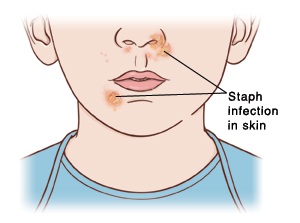Staph Infection (Non-MRSA)
A staph infection is caused by bacteria. The bacteria are called Staphylococcus aureus. These bacteria are common germs. Most healthy adults normally carry staph germs on their nose and skin. Most often, they don't cause disease. But if your skin is cut, staph can enter your body and cause infection. This can cause many kinds of problems. It may cause a mild skin infection. Or it can cause a severe infection of your skin, deep tissues, lungs, bones, and blood.
A staph infection often gets better on its own. Or it's easily treated with antibiotics. But some Staph bacteria are resistant to certain antibiotics and are harder to treat. This sheet tells you more about staph infections and what you can do to prevent them.
How does staph spread?
 |
| Because staph is carried in the nose, skin infections often occur near the nose or mouth or both. |
Staph spreads through skin-to-skin contact with an infected person. It also spreads through contact with contaminated objects. These can include:
-
Shared towels
-
Household items
-
Sports equipment
Who's at risk for a staph infection?
Anyone can get a staph infection. Some risk factors make it more likely, such as:
-
Living or having close contact with someone who has staph
-
Having an open wound or sore
-
Having a cut or other injury to the skin
-
Playing contact sports or sharing towels or sports equipment
-
A current or recent stay in a hospital or long-term care facility
-
A recent surgery or wound treatment
-
Having a feeding tube or catheter in your body
-
Receiving kidney dialysis
-
Having a weak immune system or a serious illness
-
Injecting illegal drugs
What conditions can a staph infection cause?
A staph infection often starts on your skin. It may appear as small red bumps. They may look like pimples or spider bites. These sores can turn into pus-filled infections (abscesses). Staph infections can spread deeper into your body. They may cause any of these:
-
Infections in bones (osteomyelitis), muscles, and other tissues
-
Lung infection (pneumonia)
-
Infection in a wound after a surgery
-
Infection in the blood (bacteremia)
-
Infection of the lining of your heart and your heart valves (endocarditis)
-
Illness caused by the toxins staph makes (toxic shock syndrome)
-
Blisters and raw skin (scalded skin syndrome)
How is a staph infection diagnosed?
Your healthcare provider can often diagnose a staph infection based on how it looks. They may take a sample of fluid leaking from a wound. This sample is sent to a lab to grow in a culture. With a more severe infection, other tests may be done. A sample of blood or urine, mucus from the lungs (sputum), or a biopsy of infected tissue can be tested. The samples are sent to a lab and tested for staph.
How is a staph infection treated?
A minor skin infection is often treated with warm soaks and basic wound care, including a bandage. If the infection is more severe, an antibiotic may be prescribed. This may be taken as a pill. Or it may be put on the skin as an ointment. For an even more severe infection, your provider may prescribe a more powerful antibiotic given by IV (intravenously). If you have an abscess, your provider may drain it.
How can I prevent a staph infection?
To reduce the spread of staph infections:
-
Keep cuts and scrapes clean and covered until they heal.
-
Avoid contact with the wounds or bandages of other people.
-
Don't share personal items such as towels, razors, clothing, or sports equipment.
-
Keep your hands clean. Always wash your hands:
-
Before and after making and eating food
-
Before and after caring for someone who is vomiting or has diarrhea
-
Before and after caring for a skin injury
-
After using the toilet, changing diapers, touching an animal or animal waste, blowing your nose, sneezing, or coughing
Tips for good handwashing:
-
Use soap and clean, running water. Work up a good lather.
-
Clean your whole hand, under your nails, between your fingers, and up your wrists.
-
Wash for at least 20 seconds. Don’t just wipe. Scrub well.
-
Rinse your hands well under clean, running water.
-
Dry your hands well. Use a paper towel to turn off the faucet and open the door.
Tips for using alcohol-based hand gels (when using soap and water is not possible):
-
Use a hand sanitizer that contains at least 60% alcohol.
-
Use enough gel to get your hands fully wet.
-
Rub your hands together briskly. Clean the backs of your hands, the palms, between your fingers, and up your wrists.
-
Rub until the gel is gone and your hands are fully dry. This takes about 20 seconds.
Taking antibiotics correctly
You may have heard of MRSA. This is methicillin-resistant Staphylococcus aureus. It's a type of staph bacteria that's hard to kill (resistant) with antibiotics that used to kill it. This means the bacteria can't be treated with some antibiotics (such as methicillin) that work on other types of staph. But other antibiotics can work.
Resistant bacteria can be spread by other people. Or they can develop when antibiotics aren't prescribed or taken correctly. This includes when antibiotics are:
-
Taken longer than needed
-
Not taken long enough
-
Taken when not needed
This is why:
-
Your provider may not prescribe antibiotics unless they're sure you need them.
-
You must take antibiotics exactly as your provider tells you.
-
You shouldn’t skip doses.
-
You need to take the medicine until it’s finished, even if you’re feeling better.